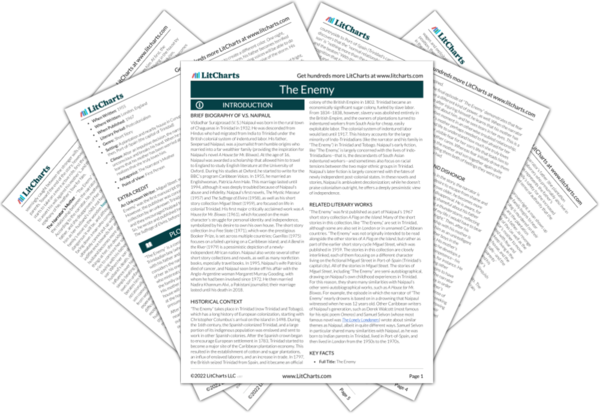The wooden house that the narrator and his family move to at the start of “The Enemy” symbolizes the narrator’s father’s drive for independence and authority, as well as the ultimately doomed nature of that desire. The narrator’s mother is afraid of moving to the house, because she knows it will provide less protection to them than the plantation barracks where they currently live, but the narrator’s father insists that they move anyway. The move from the barracks to the house is both a literal and a symbolic separation between the narrator’s father (the plantation driver) and the plantation laborers who presumably also live in the barracks. The house thus represents the father’s willingness to sacrifice his family’s safety for the increased independence, social status, and sense of authority that the house provides him.
The narrator’s mother’s fears are proven right: a man shows up to threaten the narrator’s father, the family begins to hear threatening voices at night, and their dog is murdered on their doorstep. It’s implied that these events are the plantation workers’ attempts to terrorize the narrator’s father, as revenge for the way he abuses them on the job. All of this (as well as the narrator’s father’s abuse) drives the narrator’s mother to move out, because the house has become associated with fear and revenge. But the narrator’s father chooses to keep living in the house—seemingly because he believes that the house, and the position of authority it represents, will keep him safe—and the narrator stays with him. This ruins the narrator’s parents’ marriage and creates a rift between the narrator and his mother. In this way, the house represents the narrator’s father’s continued unwillingness to admit defeat or relinquish control, even at the cost of his family.
But midway through the story, a violent thunderstorm hits. The wind blows open the windows in the house and lets heavy rain in, so thoroughly terrifying the narrator’s father that he apparently dies of fright. The house’s failure to protect the narrator’s father from his own anxieties reflects the fear and helplessness beneath his tough exterior, suggesting that he was just as fragile as the house proved to be. What the father initially valued as a symbol of his own authority becomes, instead, a symbol of his demise.













